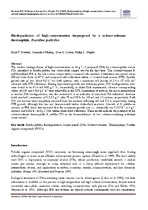| dc.contributor.author | Bustard, Mark T. | |
| dc.contributor.author | Whiting, Samantha | |
| dc.contributor.author | Cowan, Donald A. | |
| dc.contributor.author | Wright, Phillip C. | |
| dc.date.accessioned | 2010-10-05T14:41:27Z | |
| dc.date.available | 2010-10-05T14:41:27Z | |
| dc.date.issued | 2002 | |
| dc.identifier.citation | Bustard, M.T., Whiting, S., Cowan, D.A., Wright, P.C. (2002). Biodegradation of high concentration solvents by a solvent tolerant thermophile, Bacillus pallidus. Extremophiles, 6:319-323. | en_US |
| dc.identifier.uri | http://hdl.handle.net/10566/154 | |
| dc.description.abstract | The aerobic biodegradation of high-concentration,
to 24 g l
–1
, 2-propanol (IPA) by a thermophilic isolate
ST3, identified as
Bacillus pallidus
, was successfully carried
out for the first time. This solvent-tolerant
B. pallidus
utilized
IPA as the sole carbon source within a minimal salts
medium. Cultivation was carried out in 100-ml shake flasks
at 60°C and compared with cultivation within a 1-l stirred
tank reactor (STR). Specific growth rate () was about
0.2 h–1
for both systems, with a maximum cell density of 2.4 x 10
8 cells ml–1
obtained with STR cultivation. During exponential
growth and stationary phase, IPA biodegradation
rates were found to be 0.14 and 0.02 g l
–1h–1, respectively, in
shake-flask experiments, whereas corresponding values of
0.09 and 0.018 g l
–1h–1
were achievable in the STR. Generation
of acetone, the major intermediate in aerobic IPA biodegradation,
was also monitored as an indicator of
microbial IPA utilization. Acetone levels reached a maximum
of 2.2–2.3 g l–1
after 72 and 58 h for 100-ml and 1-l systems,
respectively. Both IPA and acetone were completely
removed from the medium following 160 and 175 h, respectively,
during STR growth, although this was not demonstrated
within shake-flask reactions. Growth of
B. pallidus
on acetone or IPA alone demonstrated that the maximum
growth rate () obtainable was 0.247 h–1
at 4 g l–1
acetone
and 0.202 h–1
at 8 g l–1
IPA within shake-flask cultivation.
These results indicate the potential of the solvent-tolerant
thermophile
B. pallidus
ST3 in the bioremediation of hot
solvent-containing industrial waste streams. | en_US |
| dc.language.iso | en | en_US |
| dc.publisher | Springer Verlag | en_US |
| dc.rights | Springer permits authors to deposit a post-print version of articles published by them in an open access repository. | |
| dc.source.uri | http://dx.doi.org/10.1007/s00792-001-0260-5 | |
| dc.subject | Biodegradation | en_US |
| dc.subject | Bacillus pallidus | en_US |
| dc.subject | Isopropanol (IPA) | en_US |
| dc.subject | Solvent tolerant | en_US |
| dc.subject | Volatile organic compounds (VOCs) | en_US |
| dc.subject | Thermophilic | en_US |
| dc.title | Biodegradation of high-concentration isopropanol by a solvent-tolerant thermophile, Bacillus pallidus | en_US |
| dc.type | Article | en_US |
| dc.inquiries | dcowan@uwc.ac.za | |
| dc.privacy.showsubmitter | true | |
| dc.status.ispeerreviewed | true | |

